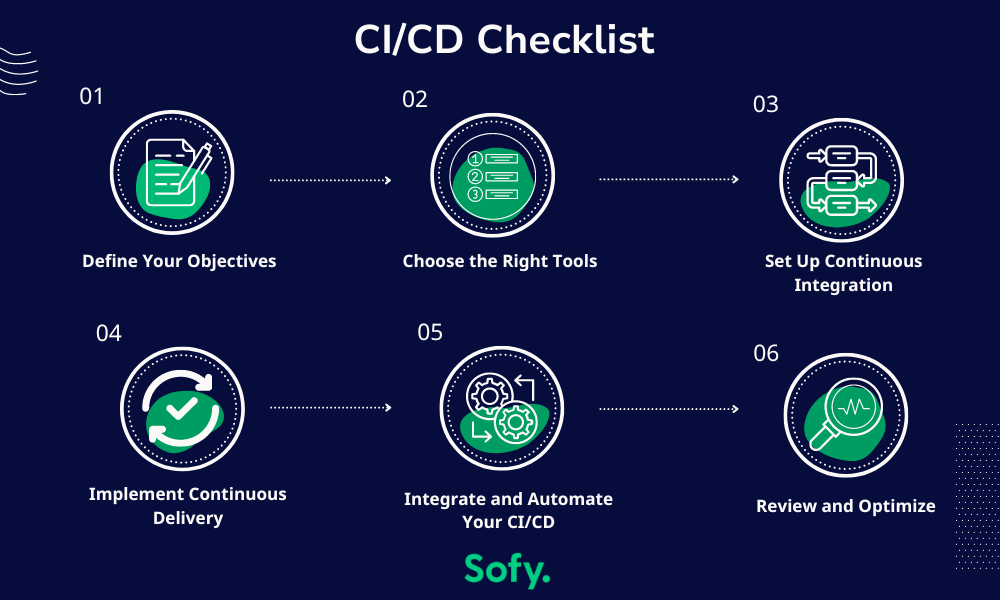Every mobile app testing team can benefit from using a CI/CD checklist.
The intertwined concepts of continuous integration (CI) and continuous delivery/deployment (CD) have paved the way for faster, more efficient mobile app development and optimization techniques. CI and CD facilitate streamlined testing, coding, deployment, and other improvements, enabling DevOps teams to serve their clients better and end users.
However, before developers can reap the benefits of CI/CD practices, they must implement the two strategies into their development processes. Doing so can be challenging, especially for DevOps teams unfamiliar with the CI/CD pipeline.
To help simplify that process, we’ve created an easy-to-follow CI/CD checklist that DevOps professionals can leverage to adopt continuous integration and delivery development processes.
What is the CI/CD Pipeline?
The CI/CD pipeline is a set of automated processes that help continuously integrate and deploy code changes. This pipeline is crucial in modern software development as it ensures you can automatically test and deploy code changes, reducing the time and effort required for manual testing and deployment.
Continuous Integration (CI)
Continuous integration automatically integrates code changes from multiple contributors into a shared repository several times daily. The primary goal of CI is to detect and fix integration issues early, ensuring that the codebase remains stable. Critical components of CI include:
- Automated Builds: Every code change triggers an automated build process, which compiles the code and creates executable files.
- Automated Testing: The build process includes running automated tests to ensure new code changes do not break existing functionality.
- Code Repository: A centralized code repository (e.g., Git) where all code changes are committed and stored.
Continuous Delivery (CD)
Continuous delivery automatically deploys every code change that passes the CI pipeline to a production environment. This ensures that new features, bug fixes, and improvements are delivered to users quickly and reliably. Critical components of CD include:
- Automated Deployment: Deploying the built artifacts to a production environment automatically.
- Monitoring and Rollback: Monitoring the deployment and providing mechanisms to roll back changes in case of issues.
- Infrastructure as Code (IaC): Using code to manage and provision infrastructure, ensuring consistency and repeatability.
CI/CD Checklist

Implementing a CI/CD pipeline requires careful planning and execution. Here’s a comprehensive checklist to guide you through the process:
1. Define Your Objectives
Before you can implement a CI/CD pipeline into your existing processes, it helps to determine what you aim to achieve with CI/CD. Do you want faster releases, improved quality, and reduced manual testing? Are you hoping to improve your app’s security? Defining these objectives will help keep you on track during implementation.
You should also establish metrics to measure the success of your CI/CD implementation (e.g., build frequency, deployment frequency, mean time to recovery).
2. Choose the Right Tools
There are several tools you should consider adopting to help manage your CI/CD pipeline, including:
- Version Control System: Use a reliable version control system like Git to manage your codebase.
- CI/CD Platform: Select the CI/CD platform that best suits your needs, such as Jenkins, CircleCI, or GitHub Actions.
- Testing Frameworks: Choose appropriate testing frameworks (e.g., JUnit, Espresso, XCUITest) for unit tests, integration tests, and UI tests.
3. Set Up Continuous Integration
To set up continuous integration in your existing process, follow these suggestions:
- Automate Builds: Configure your CI tool to automatically build the app whenever code changes are pushed to the repository.
- Run Tests Automatically: Ensure that all tests (unit, integration, UI) are executed automatically with each build.
- Static Code Analysis: Integrate static code analysis tools (e.g., Aikido, Sonar Qube, Checkmarx SAST, etc.) to identify code quality issues early.
4. Implement Continuous Delivery
To set up continuous delivery in your existing process, follow these suggestions:
- Create Deployment Scripts: Write scripts to automate the deployment process, including environment setup, configuration management, and rollback procedures.
- Configure Environments: Set up different environments (development, staging, production) to facilitate smooth transitions from development to production.
- Monitor Deployments: Use monitoring tools (e.g., GitLab, Jenkins, CircleCI) to track the health and performance of deployments and quickly address any issues.
5. Integrate and Automate CI/CD with your Testing Platform
The best way to modernize and streamline your testing strategy is by integrating and automating your CI/CD pipeline in whatever testing environment you’re currently using. As a part of this process, you can use the following process:
- Automate Tests: Use testing tools like Sofy to transform all manual tests into automated scripts, ensuring faster and more accurate testing.
- Integrate CI/CD: Integrate your testing tool with your CI/CD pipeline to run automated tests as part of your build process.
- Analyze Results: Use your testing tool’s analytics and reporting features to gain insights into test performance and identify areas for improvement.
6. Review and Optimize
Once your CI/CD pipeline is successfully integrated with your testing environment, you’ll want to continuously review it to identify bottlenecks and other areas for improvement. Communicate with your developers, testers, and stakeholders and gather feedback to refine your pipeline and testing processes.
Finally, it’s always a good idea to stay current with the latest CI/CD tools and practices to ensure your pipeline remains efficient and effective.
Best Practices for Implementing the CI/CD Pipeline
Implementing a CI/CD pipeline involves more than just following a checklist. Here are some best practices to ensure a smooth and efficient process:
1. Maintain a Single Source of Truth
Use a single version control repository for your codebase to ensure consistency and avoid confusion. Whether you’re a team of one or many, it’s essential to ensure everyone is on the same page and uses a consistent codebase.
You should also implement a clear branching strategy like Gitflow to manage feature development, bug fixes, and releases. This way, everyone in your company can follow app updates and deployments.
2. Automate Everything
You can’t argue that automated tests are the best way to catch issues early and reduce manual efforts and human error.
We recommend automating wherever possible, including:
- Tests: Automate all tests (unit, integration, UI) to catch issues early and reduce manual effort.
- App Deployments: Use deployment automation tools to minimize manual intervention and reduce the risk of human error.
- Continuous Monitoring: Implement constant monitoring and alerting to detect and address issues in production quickly.
3. Ensure Fast Feedback
With increasing demands for quicker turnarounds and frequent app releases, faster feedback is crucial to ensure developers and testers can catch issues early and reduce release times. You can obtain faster input with:
- Quick Builds: Optimize your build process to ensure quick feedback for developers.
- Parallel Testing: Run tests in parallel to speed up the testing process and reduce wait times.
- Incremental Changes: Encourage small, incremental code changes to facilitate faster integration and testing.
4. Implement Security Checks
Maintaining app security is crucial for protecting your users’ data. Ensure top-notch app security with:
- Security Testing: Integrate security testing tools (e.g., static app security testing (SAST), dynamic app security testing (DAST)) into your CI/CD pipeline.
- Dependency Management: Regularly scan and update dependencies to address known vulnerabilities.
5. Foster a Culture of Collaboration
To ensure your CI/CD pipeline implementation succeeds, you must foster a collaborative and communicative environment within your team and across your company. To cultivate this collaborative culture, you can follow these processes:
- Cross-Functional Teams: Encourage collaboration between developers, testers, and operations teams to ensure smooth CI/CD implementation.
- Regular Reviews: Conduct regular code reviews and retrospectives to identify improvements and share knowledge.
- Training and Support: Provide training and support to team members to ensure their comfort with CI/CD tools and practices.
Testing with Sofy and Integrating with Your CI/CD Pipeline

Ready to implement a CI/CD pipeline strategy into your existing processes? Well, there’s no better testing platform than Sofy to help integrate your CI/CD pipeline into your testing.
Sofy is an AI-powered testing assistant that can significantly enhance your CI/CD pipeline by automating manual test cases and providing valuable insights. Here’s how you can integrate Sofy into your CI/CD process:
- Automated Testing: Sofy uses AI to automate manual test cases, transforming them into executable scripts that you can integrate into your CI/CD pipeline.
- Seamless Integration: Integrating your CI/CD pipeline is straightforward with Sofy’s APIs and plugins to trigger automated tests as part of your build process.
- Advanced Analytics: Sofy provides advanced analytics and reporting features that give insights into test performance and app quality.
- Continuous Improvement: Integrating Sofy into your CI/CD pipeline can continuously improve your testing process. Sofy’s AI capabilities allow it to learn from previous test runs and implement self-healing tests for better performance and coverage.
Are you interested in seeing how Sofy can integrate with your CI/CD pipeline? Request a demo today and see for yourself!
Elevate Your Mobile App Development with a Robust CI/CD Pipeline
Implementing a CI/CD pipeline into your mobile app development strategy is essential for delivering high-quality applications quickly and efficiently. Following this guide’s checklist and best practices, you can set up a robust CI/CD pipeline that streamlines your development process and ensures seamless deployments.
Embrace the power of CI/CD and take your mobile app development to the next level — you’ll not only meet the demands of today’s fast-paced market but also set the stage for future success.









